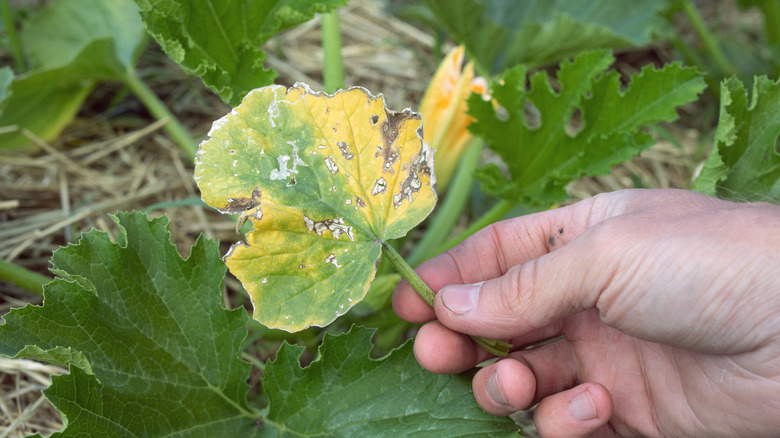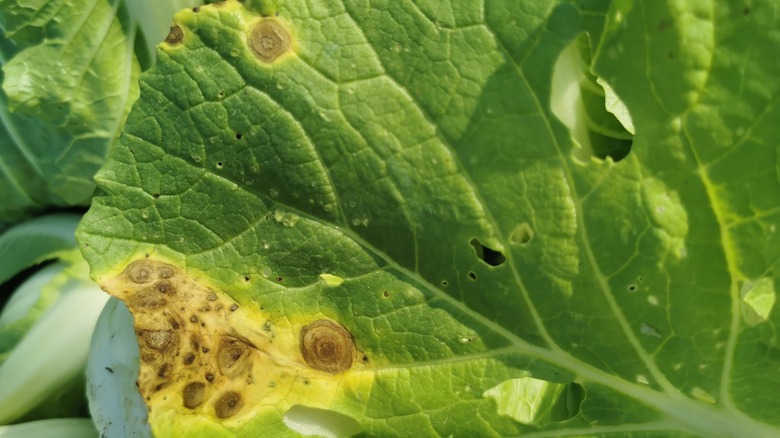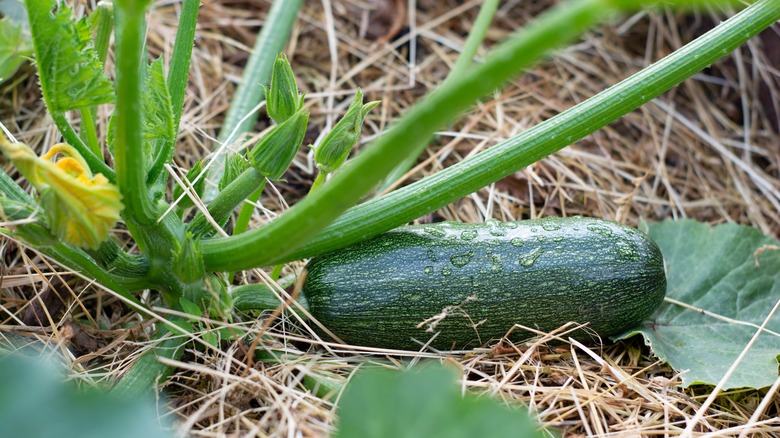Why Your Zucchini Plant Leaves Are Turning Brown (And What To Do About It)
Growing zucchini plants is incredibly rewarding... unless the leaves start turning brown. It may seem to pop up out of nowhere and will spread rapidly until your plants look scraggly and dead. If the brown coloration comes in the form of bull's eye spots, it's probably Alternaria leaf spot, sometimes referred to as early blight. It's a fungal disease caused by the fungus Alternaria cucumerina and shouldn't be confused with the tomato early blight caused by Alternaria tomatophila or A. solani. Alternaria leaf spot is a common problem among cucurbit plants, including zucchini, watermelons, cucumbers, squash, and pumpkins.
You can't cure fungal diseases in the garden, but you can control them through prevention and destruction. Preventing it from ever showing up is the goal, but if you do find it on your zucchini plants, removing it completely is the next best thing. Keeping your zukes, cukes, and other cucurbits free of this troublesome disease will take some patience and planning ahead, but it's well worth the effort so you can be up to your nose in fresh zucchini.
Alternaria leaf spot turns zucchini plants brown
Alternaria leaf spot is easy to detect once you know what to look for. It can present in a few different ways, so you might initially mistake it for something else. Brown spots are what you should be on the lookout for. These brown spots may be accompanied by yellow leaves on zucchini plants, may have small brown dots, or will look like knotholes in wood. The most common appearance is the knotholes or bull's eyes, as they're often called. The brown spots may be accompanied by tan, yellow, or different shades of brown.
This disease can also affect the fruit, typically in the form of lesions on the skin that turn fuzzy if left alone long enough. The fruit may also develop sunscald if the disease is bad enough to make leaves drop. Leaf drop is very common, so if you don't tend to the plant, you can expect the fruit to be damaged if you don't harvest them soon enough.
How to control Alternaria leaf spot
Prevention is the first step to controlling this disease, which can easily spiral out of control. Alternaria leaf spot is driven by excessive moisture and is often a bigger problem in humid areas; however, water can spread the disease just about anywhere. Mulching will help prevent water from splashing and control moisture levels. Overwatering is a common mistake when growing zucchini that can help Alternaria leaf spot spread. Along with mulching, use drip irrigation instead of watering overhead so the leaves stay as dry as possible. The disease can infect open wounds or from the tops of leaves, so it's important to keep the water in the soil.
Rotate your cucurbit crops so a planting site can go three years without them. Alternaria cucumerina can last two years in the soil on plant debris, so that third year without zukes or other plant relatives will help put the disease to rest. If you do find the disease in your garden, destroy the infected plants. Bundle them up in a plastic bag and discard them in the trash outside of your garden. Don't add them to compost because this could introduce the disease to your entire garden. If all your efforts to prevent and destroy don't help, fungicides can be used to prevent it. Follow the directions on the product label to ensure you apply it to your zucchini and other cucurbits correctly.


